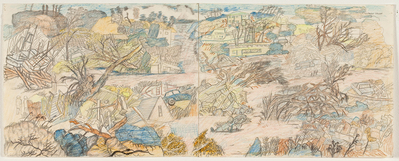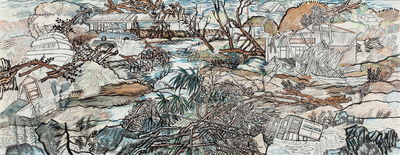Yun-Fei Ji: Migrants, Ghosts and the Dam
by Jenny Miller Sechler
Chinese artist Yun-Fei Ji is at once traditional and transgressive. At first glance, his intimate, detailed paintings and scrolls are soft and peaceful, in the style of Chinese landscape paintings. However, the images in his work include monsters, starving animals, skeletons and flooded landscapes full of upturned cars and uprooted trees. The subjects challenge the viewer. Ji’s use of traditional art forms challenges his native country’s policies, which discarded its artistic traditions after the rise of Communism. “I was drawn to using this abandoned art form and working on the ruin as a subject,” says Ji. “They fit together somehow.”
Through March 8, the University of Massachusetts Museum of Contemporary Art, at Amherst, presents “Yun-Fei Ji: Migrants, Ghosts, and the Dam,” a small but satisfying exhibit of Ji’s work. The exhibit features a short video of Ji’s talking about his work, along with two of his scroll paintings and a room with several smaller works.
Ji grew up in China during the Cultural Revolution and began his formal artistic training at the China Central Academy of Fine Arts in Beijing. He immigrated to the United States in 1989, when he received a Fulbright to study at the University of Arkansas, Fayetteville. During the time, Ji studied in Beijing. Students were taught to paint in a socialist realist style, but Ji was drawn to traditional Chinese styles and culture. He cites classic Chinese ghost stories, including those told by his grandmother, as thematic influences in his work. These influences are woven throughout the work on display at the University of Massachusetts.
The exhibit begins with Ji’s scroll paintings. Traditionally, Chinese scroll paintings were not meant to be seen all at once; rather, they were meant to be unrolled, revealing new aspects of the painting to surprise and engage the viewer. While it would be a challenge for a museum to exhibit art in this way, viewing the length of a scroll from left to right presents a narrative with shifting perspectives that deepen a viewer’s understanding of the work. The Boxers (2003), one of the scrolls on display, offers fascinating, frightening worlds of destruction along with heroic figures from Chinese folklore and history. In this painting, viewers can clearly see echoes of Otto Dix, one of Ji’s western influences, who was also known for his refusal to shrink from the horrors of war.
This exhibit also features several smaller works by Ji: The Flooded Landscape and Lower 9th Ward. Hung together, these two paintings portray almost identical scenes of cars half submerged in water, discarded bicycles and uprooted trees. The words “predator states” are written in small letters in the upper right corner of The Flooded Landscape, while a truck in the Lower 9th Ward displays the words “white knight.”
Details like these can be read as social commentary about environmental destruction and the role of the state. Specifically, The Flooded Landscape and Lower 9th Ward seem to address government responsibility in the destruction wrought by the creation of the Three Gorges Dam in China and by Hurricane Katrina in New Orleans. However, Ji’s primary interest lies in the connection between humans and nature. In the video accompanying the exhibit, Ji refers to the Confucian ideal of the virtuous man who accepts his civic responsibilities, but values the countryside as a place to nourish his spirit. Ji’s work explores what happens to this ideal when modernity threatens the natural environment.
A highlight of the exhibit is Man with a Large Mouth (2009, ink on Xuan paper), a fantastical scene of characters, monsters, a pelican and a motorcycle. The main subjects hang in the center of the drawing, and appear to be sliding precariously towards the lower left corner. The composition of the work is less conventional than others featured in the show, but keeps the tradition of landscape paintings in the way. It draws the viewer’s eyes through the work, presenting a journey with different vantage points and new things to discover.
Ji’s work is exemplary of the transformative use of art and art forms to both convey beauty and explore modern social and environmental conditions. By combining the contemporary and historic, his art provides a document of suffering, but also connects us with long-standing sources of comfort: community, folklore, tradition and nature.
University Museum of Contemporary Art
Fine Arts Center
University of Massachusetts
151 Presidents Drive
Amherst, MA 01003-9331
________________________________________________________________________________________________
Image Credit: Images courtesy of the University Museum of Contemporary Art.
________________________________________________________________________________________________
Jenny Miller Sechler is an arts writer living in Northampton, Massachusetts, where she serves on the board of Northampton Arts, Inc.



